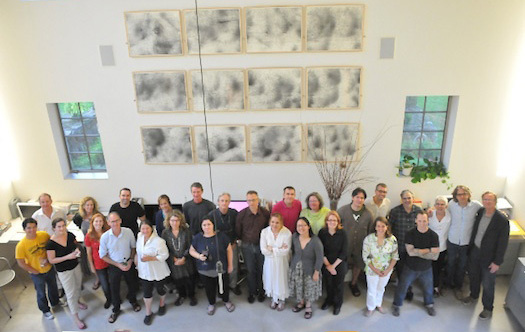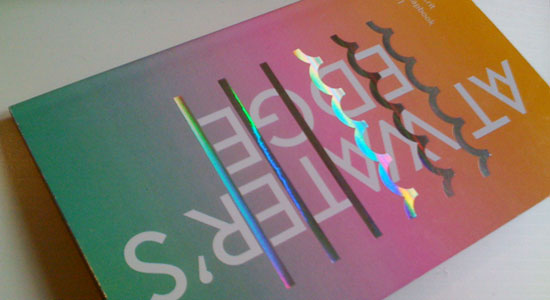It was a pleasure and an honor to go back to my alma mater, SVA’s D-Crit department, to kick-off this year’s Fall lecture series and talk about my work in the past years, with a focus on the making of the 4th Istanbul Design Biennial, A School of Schools. All my thanks go to Program Chair Molly Heintz and all the D-Crit students, alumni and family. Always such a joy to be back in my New York home.
Category: D-Crit
Things that happened

A view of Basel. Photo Wikipedia
Earlier this month, I was delighted to go back to my alma mater, the Design Criticism Department at the School of Visual Arts, to talk about design events and their changing nature in recent years. The talk was integrated in the planning of the graduating class’ final event, lead by Molly Heintz and Alice Twemlow. It was a pleasure to be back and to see the most recent generation of design critics ready for graduation!
Winterhouse Symposium on Design Education and Social Change

I was humbled and honoured to take part in the second Winterhouse Symposium on Design Education and Social Change, which took place at the Hotchkiss School in Lakeville, Connecticut, August 14-16, 2011.
The symposium’s 28 participants came together to share insights, strategies and concerns about a discipline that has experienced dramatic growth in recent years, yet remains, in its teaching, research and community-oriented practices, inchoate if not chaotic.
For me, this was an intense learning experience and I was thankful for every second of it. William Drenttel and Julie Lasky wrote a final report on the outcomes, which was published and can be read at Design Observer.
Design Crusades: Considering the Shortcomings of Social Design
On May 4th, our D-Crit class ended the program with a bang, with “Present Tense: The 2011 D-Crit Conference.” Alongside keynote speaker Rob Walker and a star-studded panel on the future of design criticism, every graduating student in our class presented on their thesis findings. My presentation was titled “Design Crusades: Considering the Shortcomings of Social Design,” and for those of you who couldn’t make it, is now available online (with all the other conference videos) and below. Best of all, it was featured in the NYTimes magazine blog as a suggestion for weekend watching!
Two billion laptops to “revolutionize educationâ€: the One Laptop per Child

Children interacting with the OLPC. Photo: OLPC
In anticipation of my presentation next week at Present Tense: The 2011 D-Crit Conference, here’s an investigation on the progress and shortcomings of the One Laptop per Child initiative, which I wrote as part of my masters thesis “Design Crusades: A Critical Reflection on Social Design.” Register for the conference here and come see me talk May 4th at 5.30pm!
There is something about Nicholas Negroponte as he nonchalantly steps onto the stage of TED in February 2006. In dark suit trousers, cotton turtleneck and dark pullover draped over his shoulders, he exudes a cool determination, channeled into his fierce gaze, his resolved step, his compelling words. “This is not something that you have to test,†he says at one point. “The days of pilot projects are over, when people say, ‘Well, we’d like to do three or four thousand in our country to see how it works.’ Screw you. Go to the back of the line and someone else will do it, and then when you figure out that this works, you can join as well. And this is what we’re doing.†The audience laughs and applauds enthusiastically as Negroponte proceeds to unveil and circulate a prototype of the One Laptop per Child (OLPC), the project he chose to dedicate the rest of his life to.
Negroponte is the founder and Chairman Emeritus of the MIT Media Lab, a recognized tech evangelist who in the previous twelve months had changed the course of his life. In January 2005, at the World Economic Forum in Davos, he announced the OLPC, a non-profit organization developing a $100 laptop that “could revolutionize how we educate the world’s children.†Sold to governments of developing countries, the computer would be distributed in mass scale to the two billion of kids in the developing world. Championing the idea of “learning by doing,†Negroponte subscribed to a pedagogical philosophy inspired by MIT colleague Seymour Papert, who defends that giving children computers aids their learning and allows them to explore on their own, outside of an educational system that is often times flawed.
The West promptly bought into and proceeded to finance this idea. In November that year, at the World Summit on the Information Society in Tunis, Negroponte sat next to Kofi Annan to show the first prototype of the little computer. It stood out with bright colors and minute proportions, a yellow crank sticking out to its side that popped out when Kofi Annan tried to turn it. This first concept was the work of Continuum, patched together to show to an eager audience. According to the Continuum’s Kevin Young, the process had to be fast, and there wasn’t much time for research. “We did speak with some educators in developing nations and talked about some of the challenges in that environment, but otherwise this was about trusting the designers’ intuition.â€
Continue reading Two billion laptops to “revolutionize educationâ€: the One Laptop per Child
Beyond

Today SVA’s MFA Design Criticism launches “At Water’s Edge,” the first in the D-Crit Chapbook series. This first volume was edited by Akiko Busch, Saundra Marcel and me, and features 10 essays from the D-Crit graduating class of 2011. You can buy the book on lulu.com or read a review by Alexandra Lange on Design Observer. I am very excited about this project! To celebrate, I share below my contribution to the chapbook—”Beyond.”
On the first day of class in September 2003, Antonio Queirós sat down in front of thirty students at the University of Porto, Portugal, and asked: “What are the words that define each of you?†He proceeded to enumerate this first exercise. Write a list of fifty words that you believe define you. Then reduce it down to three. And then to the one word. You have a week.
Hardly a graphic design exercise, I remember thinking, leaning against a window and trying to evaluate this redheaded forty-something teacher. But then I started my list.
The word I chose was beyond. It sounds pretentious when I say it now, but when I first presented it to class I had the brilliant idea of saying it in Spanish—mas allá. Much better than the Portuguese version of the word, I thought. More accurate, I believed. It reminded me of a folk tale I had heard in my teenage years, in which a firstborn son digs in vain through the hills of the Iberian Peninsula, searching for his dead father’s buried treasure chest. He keeps encountering paper scrolls, every one of them bearing the same message—mas allá, go beyond.
Continue reading Beyond
Tracing Ephemera

MTA token machine, used 1954-1975.
This essay was written for D-Crit’s “Researching Design” class by Steven Heller. Students are forbidden to use Google or any search engine in their research projects, and discover the joys of archives and libraries again. Starting today, I will be posting a weekly essay from my two years at D-Crit.
In a morning like any other morning, you might leave your apartment, walk two blocks to the subway, hope to find a seat in the crowded car and dodge standing passengers while getting out of the car into the station of your choice. The period of time you spend in the subway is uneventful. You read, listen to music, stare into space.
On that particular morning, I was staring into the void after checking out everybody’s shoes, when the PA announcer started trailing off the usual audio script. “Have a good day,†she said. “It’s Friday, almost the end of the week. Have yourself a good weekend, too. Don’t forget to take all of your belongings with you, and please mind the gap between the train and the platformâ€. This nice interlude woke me from my trance, and I noticed everybody on the train car was smiling.
“Even the conductors sometimes embellish the PA ads,†Doris Halle pointed out to me, over the telephone. According to Ms. Halle, formerly Chief of Corporate Design at the Metropolitan Transit Authority, the people that spend so much time underground in the New York City Subway, whether conductors, station agents or booth agents, find a way to make the subway system a little bit theirs, too. Whether a message written for the day on the station booth, or a sign posted on the platform columns indicating which way to go during a weekend traffic change, MTA staff adds on to the existing subway signage system, in complex, humorous, and whimsical ways.
These characteristics were first apparent to me when I looked at the token machines on display at the MTA Transit Museum. One of them stood out immediately. It was red and black, simple in its rectangular lines, and heavily customized during the period of 1954 to 1975, when it was in use. During this period, the fare amount increased four times, from 15 cents in 1954, to 35 cents in 1972, and several changes had been made to the amount that should be inserted in the machine. By adding tape, painting arrows or sticking hand-cut letters, the machine had evolved through time, becoming a hybrid object that told the story of the people that had customized it. The details were gritty and unkempt, but the additions had been done with care and some amount of logic. This was undoubtedly the product of the intense labor of some MTA employee.
Customized out of necessity, this token machine existed completely out of synch of the rest of the subway signage system. But when had the MTA staff first started intervening in the signage system? And had these interventions been consistent throughout time?
Continue reading Tracing Ephemera